Subscribe now to get notified about IU Jharkhand journal updates!
A Study Of Customer Attitude Towards Online Shopping In Solan District Of Himachal Pradesh
Abstract :
India is a large and strategic consumer market. People in India prefer to shop online these days. Hence, retailers are devising strategies to meet the demand of online retailers. The present research paper has used qualitative and quantitative research methods to study the impact of demographic factors of consumers on on-line shopping parameters like satisfaction with online shopping, frequency of on-line shopping, amount of items purchased, and overall spend on on-line shopping.The data were collected through structured Questionnaire.
Keywords :
E-Commerce, Customer satisfaction, Online Shopping1. Introduction:-
Purchasing products or services over the Internet, online shopping has attained immense popularity in recent times, mainly because people find it
convenient and easy to shop from the comfort of their home or office and also eased from the trouble of moving from shop to shop in search of the
good of a choice.
A platform where consumers can directly buy goods and services over the internet is known as Online Shopping. In simple words Online shopping is
defined as purchasing items from Internet retailers in spite of purchasing through a store or the act of purchasing products or services over the
Internet. It is a B2C Online Shopping where consumers directly visit a website or compare products, prices, specifications on various online
portals.
Due to revolution in telecommunication sector, internet is developed as another basic need in addition to food and shelter. The Internet has
changed the way consumers shop and buy goods and services. The Internet provides opportunities for both companies and consumers. These days,
both domestic and international companies have started using the Internet for the promotion of their product with minimum cost and thereby
reducing the price of the product in order to face competition and remain ahead of its competitors. Companies also communicate, disseminate
information, sell their products, receive feedbacks and also conduct satisfaction surveys among customers via internet.
These days, customers can not only purchase the product, but also compare prices, features of the product and after sales services.
The popular online retailing companies in India are Myntra, Flipkart Snap deal, Amazon.com and e-Bay etc. The major attributes which influence
consumer perceptions for online shopping are informative, easy to use, satisfaction on prices and quality of products, security, proper
utilization of available information to compare the different products.
2. Review of literature
Childers et al. (2001) analysis find out that the customer has chosen comfortable and navigations for using the ecommerce site, which give
shopping experience and enthusiasm.
Prashant Singh(2014) in his article “Consumer’s Buying Behaviour towards Online Shopping A case study of Flipkart.Com user’s in Lucknow City”
published in Abhinav stated that future of e-retailers in India looking very bright. E- retailers provides customers the best option to save
money and time through purchasing online and also in their budget. Flipkart is offering them world class facilities and high discounts. The
success of e retailers depends upon the brand image, policies of the company.
3. Research methodology applied
A feeling of favorableness or unfavorableness that a person has towards an object is called customer attitude. As if a consumer likes a product,
he will develop a positive attitude towards the product and vice versa. Consumer attitude basically comprises of beliefs, feelings and behaviour
towards an object. It is very important to study consumer attitude to determine the satisfaction level of customer towards product or services.
Also to retain a customer, it is required to study consumer attitude.
In the specific area of Solan district of Himachal Pradesh, the objectives of the study are:
- To know the variables that influence customer intention to purchase online.
- To find out the consumers' satisfaction level of services provided by the online shopping
The researcher has adopted exploratory research design and data has been collected through a structured questionnaire. The sample size is determined as 100. Respondents chosen are those people who are presently purchasing products through the online portal. A pilot study was carried out from 20 respondents and necessary corrections were made based on feedback from pilot study respondents.
4. Hypothesis of study
Ho: There is no significant relationship between personal factors and the frequency of products/ services purchased online.
H1: There is a significant relationship between personal factors and the frequency of products/ services purchased online.
5. Data analysis
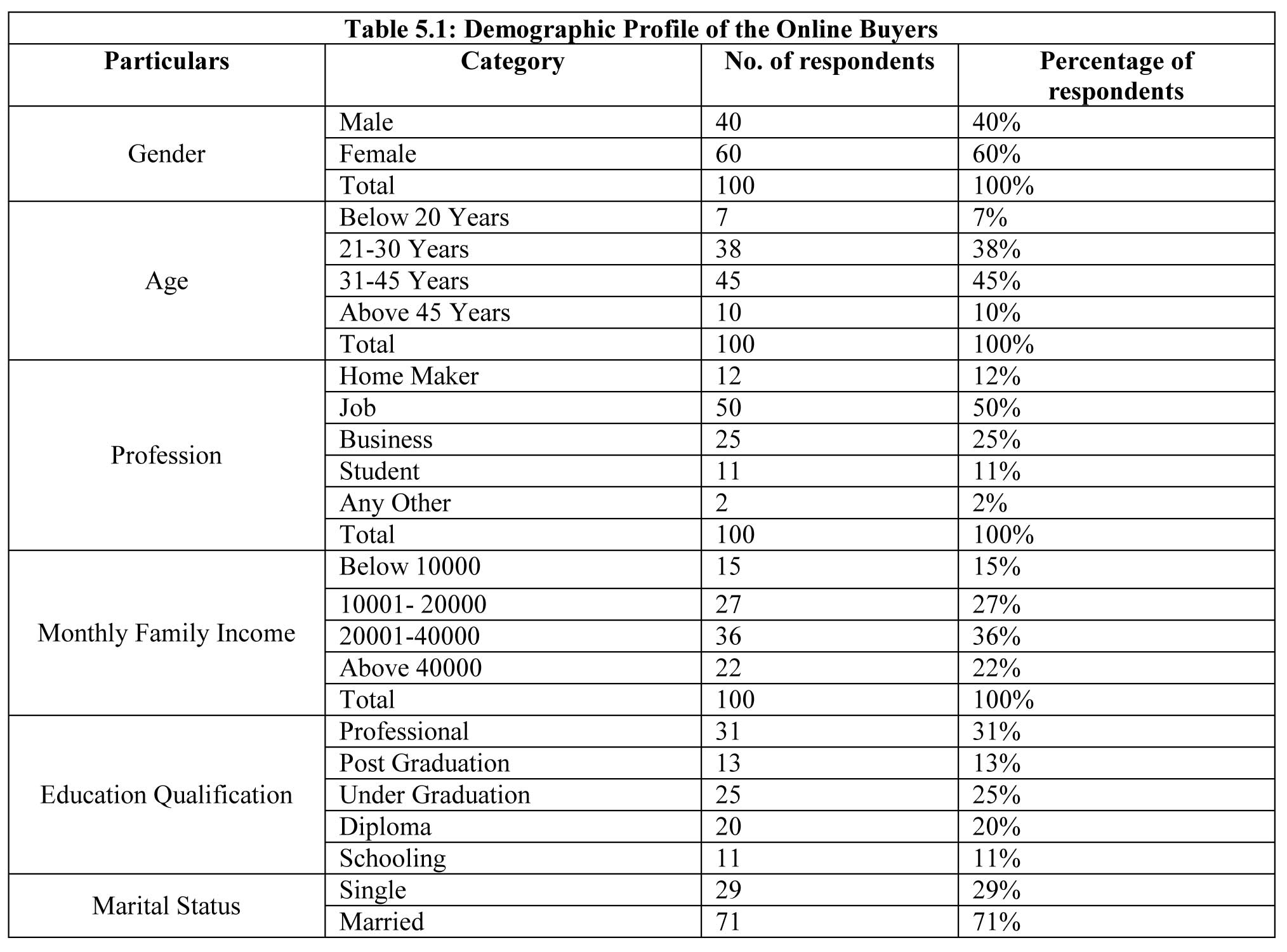
The demographic profile of online buyers is depicted in Table 5.1. It shows that out of 100 respondents. The majority of females prefer to purchase via an online portal. The majority of respondents are falling under the age group of 31-45 Years. Most of the participants are professionals and falls under the category of monthly income of 20001-40,000.
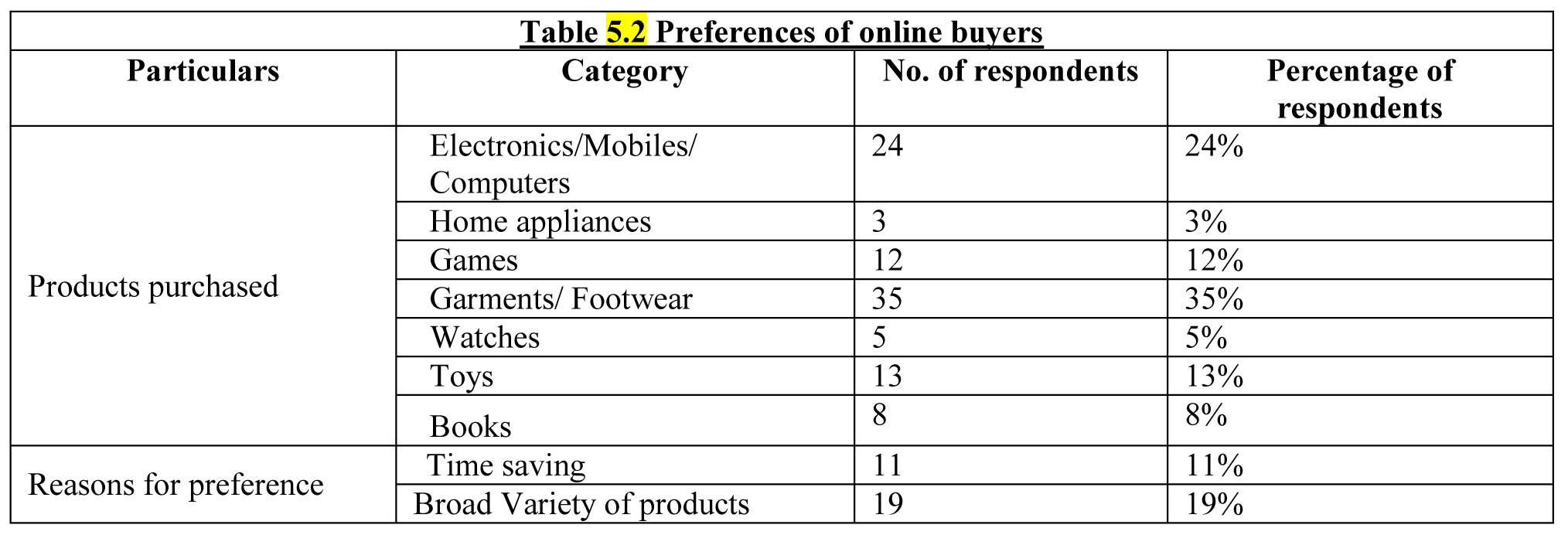
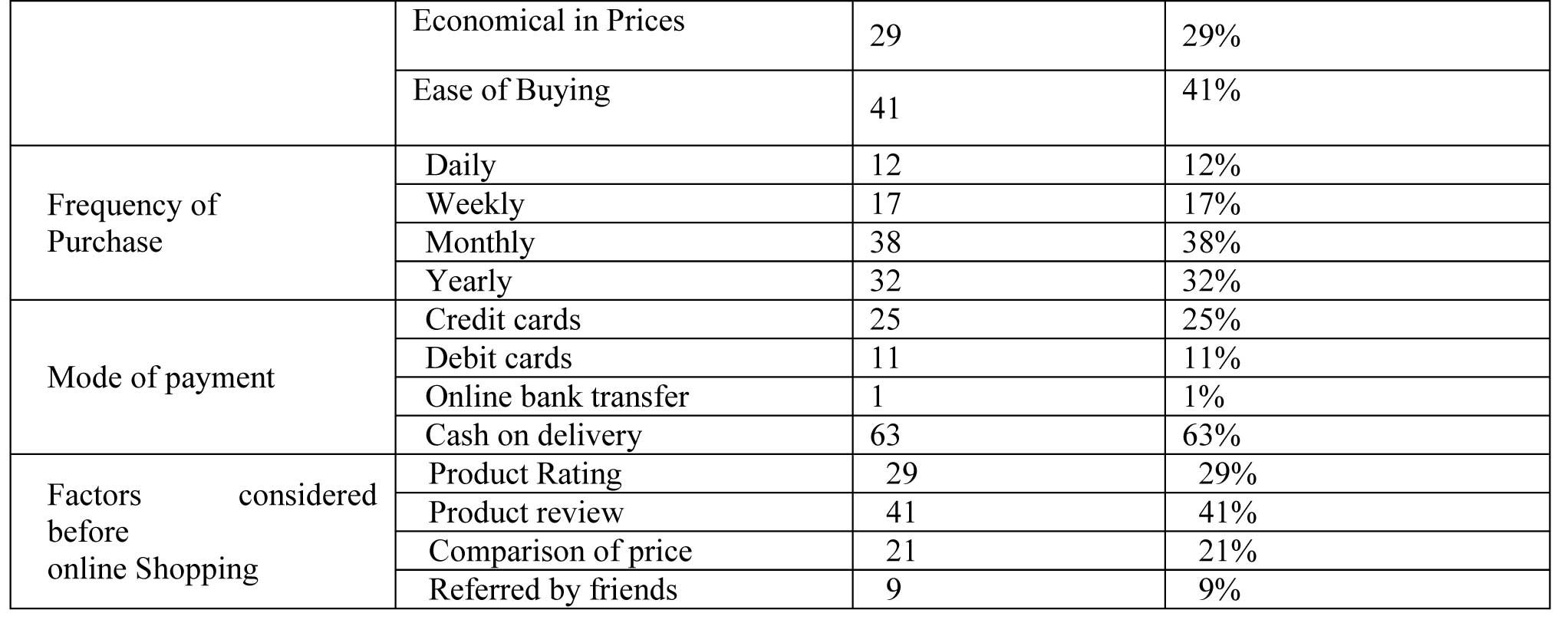
Table 5.2 depicts the preferences of the respondents, while online shopping. 35% respondents prefer to purchase garments/ footwear, followed by 24%
respondents who prefer to purchase electronics/ mobiles etc. 13% prefer Toys,12% respondents prefer games, 5% prefer watches and remaining 3% prefer
to buy home appliances. Respondents were asked about the reasons for purchasing online. 41% responded the reason being ease of buying, 29%
respondents feels that products are economical because of discount offers, 19% respondents feels that broad variety of products are available at
online portals and 11% respondents feel that it saves their time as they can access this service 24*7 .
38% respondents prefer to purchase on monthly basis followed by 32% respondents who prefer to purchase yearly. 17% and 12% respondents respectively
prefer to purchase on weekly and daily basis. Research shows that 63% respondents prefer to pay via Cash on Delivery followed by 25% respondents who
prefers Credit card facility to pay for online shopping. 11% and 1% respondents prefer debit card and online bank transfer facility respectively for
payment. Respondents were asked about the factors they considers before online shopping.41% buyers responded that they follow Product review before
placing an order, 29% responded that they check product rating, 21% responded that they compare prices of product on other portals and remaining 9%
responded that they discuss with their friends.
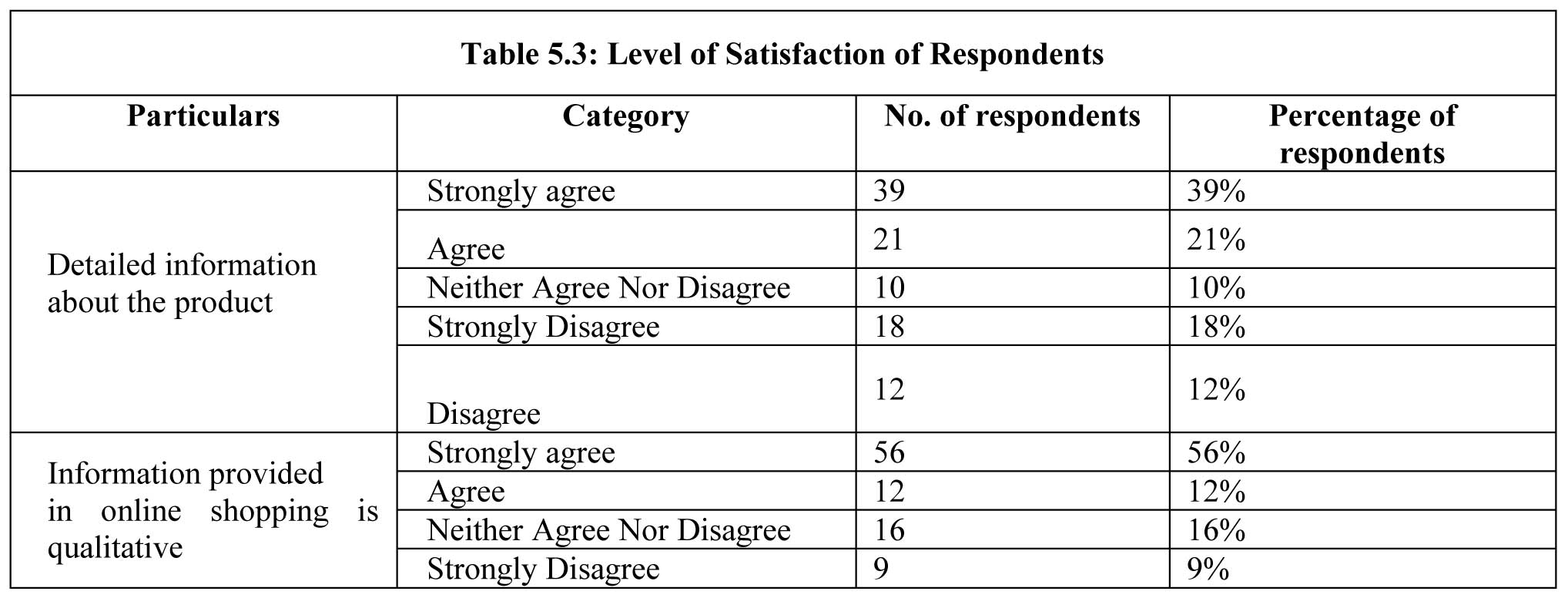

Table 5.3 depicts the level of satisfaction of respondents towards online shopping.
Respondents were asked about if detailed information of the product available on portal. 39% respondents strongly agree with the statement followed
by 21% respondents who agree that information displayed is detailed.18% and 12% respondents respectively strongly disagree and disagree with the
statement. 10% respondents are neutral towards the statement.
56% respondents strongly agree that information provided is qualitative followed by 16% respondents who are neutral towards statement. 12% respondents
agree with the statement, 9% and 7% respondents strongly disagree and disagree respectively with the statement. Respondents were asked about if they
feel online shopping is safe and secure. 42% respondents agree that they feel safe and secure followed by 26% respondents who feel that they neither
agree nor disagree with the statement. 16% and 14% respondents respectively strongly disagree and strongly agree with the statement.
Respondents were asked about the their online shopping experience.76% respondents are satisfied followed by 16% respondents who are highly satisfied
and remaining 6% are neither satisfied nor dissatisfied with their online shopping experience

Table 5.4 depicts the problems faced by the respondents, while online shopping. 69% respondents did not face any problems while shopping online.
12% respondents were not satisfied with the quality of product they received. 10% respondents feel that the delivery charges they have to pay if
product price is less than 500, is quiet high.7 % respondents received product after the expected time and 2% respondents feel that the product
they received differs from the product they purchased.
*Other factors includes Internet Connectivity problem, like to see product in personal etc.
Hypothesis Analysis
H0: There is no significant relationship between gender and the frequency of products / services purchased online.
H0: There is no significant relationship between age and the frequency of products / services purchased online.
H0: There is no significant relationship between profession and the frequency of products / services purchased online.
H0: There is no significant relationship between monthly family income and the frequency of products / services purchased online.
H0: There is no significant relationship between marital status and the frequency of products / services purchased online.
H0: There is no significant relationship between education level and the frequency of products / services purchased online.
H0: There is no significant relationship between products purchased and the frequency of products / services purchased online.
H0: There is no significant relationship between reasons of preference and the frequency of products / services purchased online.
H0: There is no significant relationship between Mode of payment and the frequency of products / services purchased online.
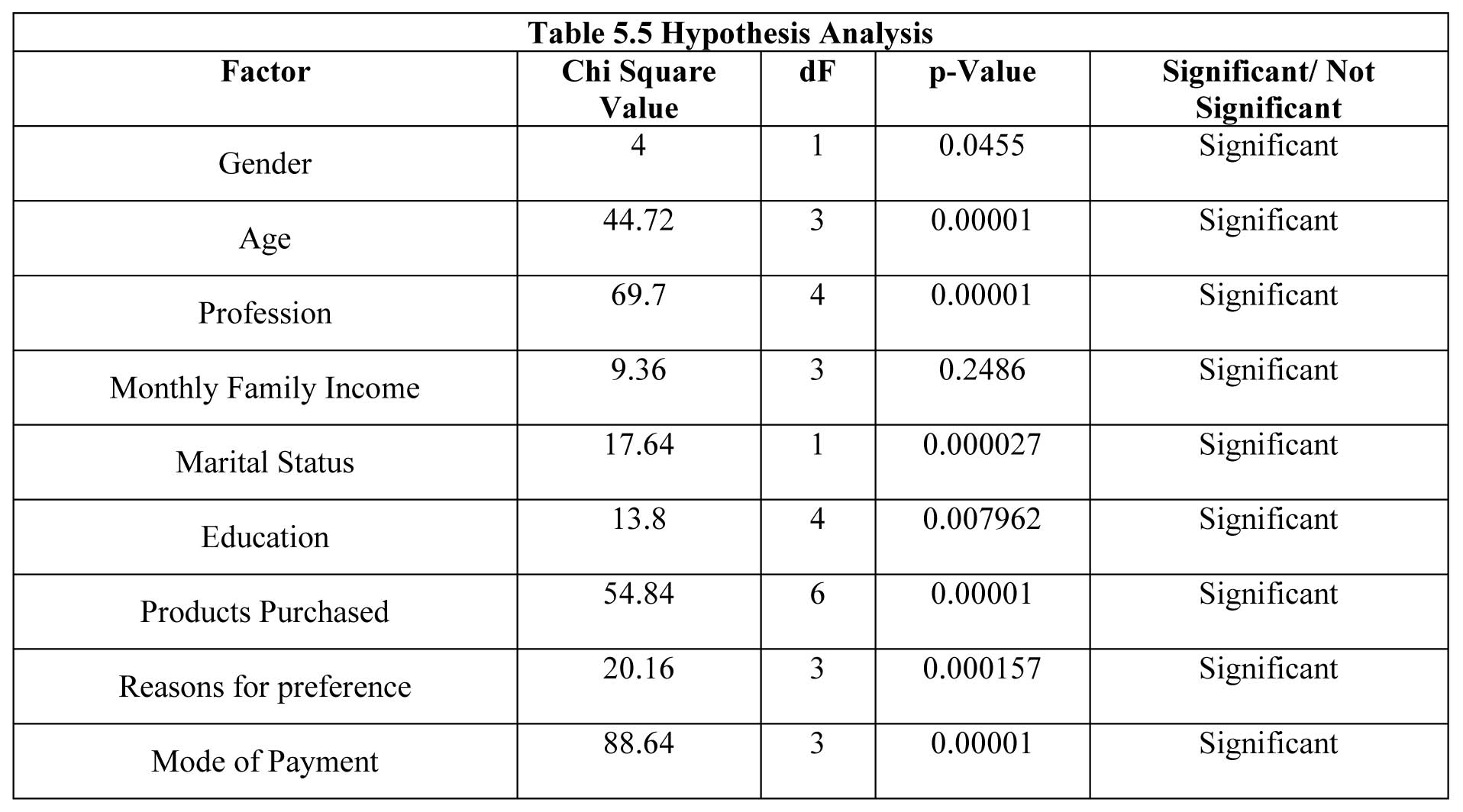
It is clear from the above table that hypothesis is rejected in all cases (Significant as p value < 0.5). So, it can be concluded that all factors have significant influence on frequency of purchase of products through online mode.
6. Findings
The research shows that among 100 respondents chosen in the region, 60% belongs to female category, while 40% belongs to male category. The majority of respondents are among the age group of 31-40 who are employed at some organization and fall under the income group of 20,001-40,000 monthly. Research also shows that most of the respondents are comfortable and anticipated more in online purchase and usually purchases monthly. Monthly Income also has an impact on frequency of purchase.
The respondents prefer to purchase garments and electronic items from online portals. The most important motivating factor, which influenced the online shopping, is convenience in purchasing followed by a broad variety of products available on online portal.
These motivations are considered as the main motives for adopting online shopping as an alternative method of shopping because it helps cut the costs of transportation and parking for cars, provides a wider choice of products, and enables access to varying degrees of quality, prices and convenience.
The payment mode for online shopping included Cash on delivery, credit card, cheque, and various coupon methods. The Maximum of respondent utilizes cash on delivery option followed by Credit Card. It shows that respondents try to reduce risk by opting Cash on Delivery Option. Research also shows that respondent prefers to review rating, feedback and compare prices of same product on different portals before placing an order.
Researcher tried to find out the satisfaction level of respondents on various attributes towards online shopping and found out that respondents are highly satisfied with the information displayed about the product and feel that it is quite beneficial for them. The majority of the respondents feel that online shopping is safe and secure. This satisfactory analysis depicts that the respondents are highly satisfied with their online shopping experience.
7. Suggestions
E-retailers should develop innovative ways so that people start purchasing other goods and services. Companies should introduce better technologies which are safe and secure enough to gain confidence in the payment system among the customers. Most of the customers prefer to purchase goods through Cash on Delivery (COD) mode, whereas few online portals do not offer COD facility. Hence, in order to attract new customers and to retain existing customers,it is necessary to provide this facility. Thus, in this competitive era all the online marketers should try to satisfy the customers to hold back the customers and to launch more offers and discount to attract the new customers.
8. Conclusion
This research paper has made an attempt to understand various buying behaviour dimensions of customers in the Solan district of Himachal Pradesh. Percentage method is used to analyze the various parameters to examine the relationship.
It clearly indicate that majority of respondents visited frequently the online websites. The easy to access and convenience produce by these websites for 24 hours and seven days make the customer feel more comfortable.
The present study revealed that risk, product features are also a major impact on customer intention to take the buying decision. Online retailer wants to try to minimize the risk of transactions among the customers.
This can be reduced by implementing money back guarantee and easy to exchange the product, quality merchandise, protects online transaction and effective customer services. Credit ration from customer side would also reduce risk and improve their company brand image. The online retailer should concentrate on quality packaging that can minimize the product damage and tampering. Online retailer should focus on delivery of right product to the customer point to
prevent undelivered of merchandise ordered and high cost of delivery the online purchase. Online buyers will find the easy and understandable navigation of websites. Retailers should give adequate information about the product, facility to compare the product on various aspects such as price, quality, dimension, etc. which would help the customer in making the better choice. Providing better customer service by the way of quick response to customer questions, rapid handling of customer queries and complaints would improve the brand image of online retailer. In this research, an effort has been made only to study customer variables. In future research, there is a scope for researchers to study retailer’s features and its influence variables on buying behavior decision. Hence the scope is large.
8.1 Limitations Of The Study
The survey was conducted in District Solan of Himachal Pradesh with a small sample size of 100; a larger sample size is desirable.
8.2 Theoretical Implications
This study provides a foundation for the future researchers in studying the consumer behavior of Indian online shoppers. Further research can be possible by increasing sample size including a rural population that may reflect the entire scenario of consumer behavior of online shopping in India. Furthermore, the variables that have been identified in this study may not be sufficient rather more variables are to be considered in future research. Researchers may also look for Factors That Influence The Online Shopping Behavior, Customer Satisfaction, And Loyalty.
8.3 Managerial Implications
The findings of the paper yields some managerial implications It provides guidelines to the manager about the attributes that must be included in their products and service quality, mode of delivery channel, security, trust worthiness ,and pricing strategy. As customers prefer CoD, managers must maintain the cash on a delivery program to gain trust among the customers. Another alternative is managers can send alternative products to the customer to choose from options and pay after they prefer one. If the managers want to attain competitive advantage in market, then manager may consider above suggestions.
References:
- Bhatt Ashish, Consumers attitude towards online shopping in selected region of Gujarat, Journal of Marketing Management, ISSN-2333-6080, Vol.-02, and No.-024.
- Deshprabhu-Sadhekar Poonam, Periera Naila(2018), Customer Attitude towards Online Shopping- A case study, International Journal of Advanced Scientific Research and Management, Volume 3 Issue 10, Oct 2018
- Lakshmi. S, SE, Consumer Buying Behavior towards Online Shopping, (2016). International Journal of Research – Granthaalayah. Vol. 4, No. 8: 60- 65.
- Nagra Gagandeep, Gopal R, A study of Factors Affecting on Online Shopping Behavior of Consumers. International Journal of Scientific and Research Publications. Volume 3, Issue 6, ISSN 2250-3153, (June2013).
- Novak, T.P., Hoffman, D.L., and Peralta, M. (2000), “Building consumer trust online", Communication of the ACM”, Vol. 42, No. 4, pp.80-85.
- Pavlou, P. A. (2003), “Consumer Acceptance of Electronic Commerce: Integrating Trust and Risk with the Technology Acceptance Model”, International Journal of Electronic Commerce, Vol.7, No.3, pp. 101-134.
- Ravjot Kaur,Gurmeet Kaur,Aman Kumar, Gaurav Kumar (2015), Customers attitude towards online shopping in Chandigarh, International Journal of management and social Sciences, Research,ISSN2319-4421,Vol-4, No.-3
- Swaminathan, V., Lepkowska-White, E., & Rao, B.P. (1999), “Browsers or Buyers in Cyberspace? An Investigation of Factors Influencing Electronic Exchange”, Journal of Computer-Mediated Communication, Vol. 5, No.2.
- Selvaraju & Karthikeyan (2016). Impact on E-Commerce towards Online Shopping and Customer Buying Behavior Asian Journal of Research in Social Sciences and Humanities, Vol. 6, No.7, pp. 1260-1270.
- Upasna K. (2012), “E Commerce in India; Early birds, expensive worms”, Consumer and Shopper Insights, McKinsey Report, July 2012, P.1
